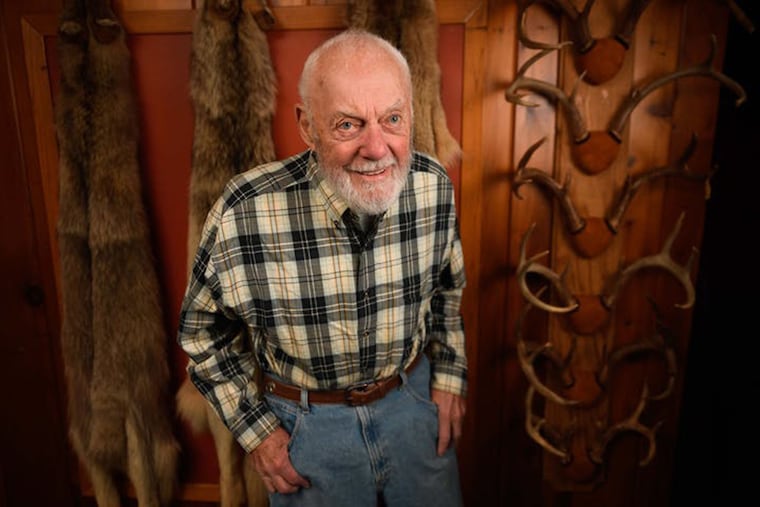For one of the oldest living Eagles, fond memories of his days in green — and hopes for a Super Bowl win
Bud Grant earned a spot in the Pro Football Hall of Fame mostly for his work as coach of the Minnesota Vikings. But his NFL career began in 1951 with the Birds.

Not surprisingly, one of the Eagles’ oldest living former players would like to see the team from Philadelphia win Super Bowl LVII.
“I’m proud to say I was an Eagle,” Harold Peter Grant Jr., who is 95 and more than 70 years removed from his last Eagles game, said cheerfully over the phone from his home in Bloomington, Minn. “I’m pulling for them.”
You probably know Harry Grant better as Bud Grant — the same Bud Grant who coached the Minnesota Vikings from 1967 to 1983, compiling a 158-96-5 record and leading the Vikings to four Super Bowls.
Bud Grant was inducted into the Pro Football Hall of Fame in 1994. He is the second-oldest living Hall of Famer to Marv Levy, 97, the former coach of the Buffalo Bills. (Bud and Marv each lost all four Super Bowls their teams played in, but let’s skip that part for now.) Although the NFL doesn’t keep official records of these things, he is one of the oldest living former Eagles and may be the oldest.
Bud never looked to me like he was having much fun on the sidelines, but he was a heck of a coach. The Vikings of my youth were famous for their legendary defensive line, known as the Purple People Eaters, and for their mobile quarterback Fran Tarkenton, “Fran the Scrambler,” who was the Patrick Mahomes of his day. (Tarkenton just turned 83, by the way.)
As frosty as it got late in the season in Minnesota, Bud never looked cold.
Bud was in his 14th season when the Eagles finally beat his Vikes — actually the Eagles’ first victory ever over Minnesota. That was in September 1980, the year Dick Vermeil’s Eagles would make their first Super Bowl. I covered the Eagles’ 31-16 playoff victory over the Vikings later that season on a snowy Saturday afternoon at ice-cold Veterans Stadium for the old Lancaster Sunday News.
What I did not know until recently was that Grant excelled as a defensive and offensive end for the Eagles in 1951 and 1952. These were also the only two seasons Grant played in the NFL. His arrival and departure were interesting, each in its own way.
Grant grew up in Superior, Wis., but attended college at the University of Minnesota after serving in the U.S. Navy. As was then common, he played football, basketball, and baseball for the Gophers. He won nine varsity letters and was a two-time All-Big Ten player in football.
The Eagles made him their first pick, 14th overall, in the 1950 NFL Draft. But Bud had joined the Minneapolis (now Los Angeles) Lakers, the city’s pro basketball team, a year earlier. He was a reserve for a team that won the 1950 National Basketball Association championship.
Grant, who was 6-foot-3 and 200 pounds, remembers Eagles officials dropping by one of the Lakers’ games in his second year in Philadelphia, against the old Warriors, and telling him they’d love to have him play football.
During that second NBA season, though, Bud realized something about basketball: “I could play, but I couldn’t go much higher,” he said, literally and figuratively.
So he signed with the Eagles for the 1951 season, but it wasn’t until the following season that Grant made his mark. Grant had a fantastic 1952, catching 56 passes, second in the NFL, for 997 yards and seven touchdowns. He caught an 84-yard touchdown pass from Adrian Burk in the first quarter of the season opener. The highlight film from the season is titled on YouTube, “Bud Grant Sparks Eagles’ Come-Back Season.”
Although the city of Philadelphia was more crowded than Minneapolis, Bud says now he liked playing for the Eagles. He and several of his teammates lived at the old Walnut Park Plaza. He became friends with Chuck Bednarik, the legendary two-way player from Penn.
Grant, an avid outdoorsman, enjoyed driving to South Jersey to hunt ducks and geese.
“I wasn’t in purgatory or anything,” Grant said of playing far from home.
In 1953, Grant found himself at a crossroads. The Winnipeg Blue Bombers of the Canadian Football League offered a $10,000 contract, above the $7,000 he was making with the Eagles. Winnipeg was closer to his family. The Canadian dollar, at the time, was worth a little more than the American dollar. Grant had little to consider. He jumped.
Grant played in Winnipeg for four seasons, then became their coach in 1957 at age 29. He became the Vikings’ coach in 1967. Philadelphia is a footnote in his glorious football career.
When he was told that he was possibly the oldest living ex-Eagle, he said, “I don’t know if that’s good or bad, but at least we’re talking.” He laughed.
After Grant left for Canada, Frank McNamee, the Eagles’ president, told an Inquirer reporter in 1953 that Grant “did not like Philadelphia, nor the people in Philadelphia. He told us he wanted to play among his own people. So he obviously prefers the people of Winnipeg, which is close to Minnesota.”
Seventy years later, Bud Grant insists that is hogwash. He liked playing in Philadelphia, although coaching against the Eagles would prove to be a little more challenging. Nevertheless, he will be pulling hard Sunday for the team in green.
“Having said that, the Eagles fans are the toughest,” he said. “They were the toughest around that I ever played in front of in my life.”
Dave Caldwell grew up in Lancaster County, graduated from Temple University, and lives in Manayunk. He was a sports reporter for The Inquirer from 1986 to 1995.